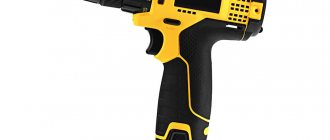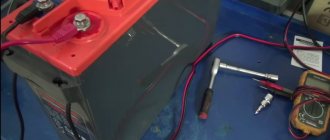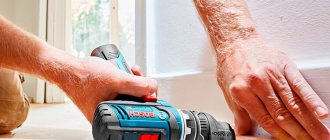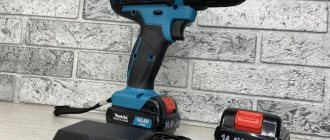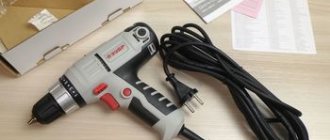Types of batteries for screwdrivers
The diversity of rechargeable batteries is due to the fact that various chemical elements can be used as electrodes and electrolytes. The quality of operation of the power tool used depends on the correct choice of energy storage device. The following 4 types are most widespread in the field of electrical appliances:
- nickel-cadmium (Ni-Cd);
- nickel metal hydride (Ni-MH);
- lithium-ion (Li-Ion);
- lithium polymer (Li-Pol).
Let's take a closer look at each of them.
Nickel-cadmium batteries
Despite the fact that this species appeared at the end of the 20th century, their mass production began only in the middle of the next century. They use nickel as a positive electrode and cadmium as a negative electrode. Most often they have the shape of a cylinder, for which they received the popular name “banks”.
Nickel-cadmium batteries used to operate screwdrivers have a number of advantages:
- can be operated at low temperatures without much loss of charge, which is a huge plus when working outside in winter;
- up to 1000 charge-discharge cycles;
- there is no risk of spontaneous combustion;
- high load capacity;
- can remain in a discharged state for a long time without losing their properties;
- the ability to restore failed batteries;
- can be used until completely discharged.
Despite the existing advantages, Ni-Cd batteries have some disadvantages:
- toxicity of substances filling the “jar”;
- complex disposal of used devices;
- heavy weight;
- self-discharge of the battery, which reduces capacity and voltage;
- memory effect, which occurs when the battery is not completely discharged and subsequently reduces its capacity.
It should be noted that nickel-cadmium batteries are recommended to be stored in a completely discharged state.
Nickel metal hydride batteries
The creation of this type of element began in 1970. However, the unstable operation of the first samples necessitated the search for new metal hydride alloys. It was only after the 80s that Ni-MH batteries were improved. The new type of battery has the following advantages:
- they have virtually no memory effect;
- no toxic components are used in their production;
- ease of disposal;
- capacity is 30% greater than that of nickel-cadmium;
- light and compact;
- are not afraid of mechanical damage.
Minuses:
- takes a long time to charge;
- 500-600 charge-discharge cycles;
- after 300 cycles, a decrease in capacity can be observed;
- cannot be used at sub-zero temperatures;
- cannot be completely discharged;
- higher cost compared to the previous type.
Store nickel-metal hydride batteries half-charged and in a cool place.
Li-ion batteries
Li-Ion batteries appeared in the 90s thanks to Sony. The first elements of this type were characterized by increased explosiveness. Only 20 years later they got rid of this problem. Currently, this is a battery with high performance and a number of advantages over the previous ones:
- short charging period;
- there is practically no memory effect;
- minimal self-discharge;
- the capacity does not decrease when charging an incompletely discharged battery;
- absence of toxic components in the composition;
- long service life.
Despite the apparent advantages of lithium-ion batteries, there are some disadvantages:
- mechanical damage must not be caused, because there is a possibility of an explosion from impact;
- quickly fail under severe discharge;
- are not subject to restoration measures;
- discharge quickly at sub-zero temperatures.
Lithium polymer batteries
This type of battery was developed based on lithium-ion batteries. The difference is that the liquid electrolyte has been replaced with a gel-like polymer. This, first of all, increased the safety of using these elements. In addition, the capacity has increased, and the weight and dimensions, on the contrary, have decreased. So, the pros:
- no memory effect;
- practically no self-discharge;
- have a higher capacity than Li-Ion;
- can be very thin (up to 1 mm) and of various shapes;
- can be used in temperature conditions from -20 to +40 Celsius.
Disadvantages of Li-Pol batteries:
- service life - no more than 3 years;
- expensive;
- cannot be completely discharged;
- There are many nuances of operation and charging.
For screwdrivers, this type of battery is rarely used, which is due to its high cost.
It is difficult to say unequivocally which battery is better for screwdrivers. Each type of battery has its own advantages and can be used in different conditions. For rare everyday use, nickel-cadmium batteries are more suitable, as they can be stored for a long time without loss of properties. In addition, they can be used outdoors at low temperatures. If you use a screwdriver often and for a long time, then it is better to give preference to lithium-ion batteries. They are more capacious, do not self-discharge and quickly become infected.
Thus, the choice of battery for a screwdriver should take into account the features and operating conditions, as well as the tasks assigned to the power tool.
Below are the best, according to users, rechargeable batteries for screwdrivers from the most popular companies: Bosch, Hitachi, Makita.
Which battery is best for a screwdriver: leading manufacturers
Manufactures high-quality batteries:
- INTERSKOL , demonstrating the optimal price-quality ratio. The choice can be made in favor of Ni-Cd models with a capacity of 1.3–2 Ah and a voltage of 12, 14.4 or 18 V;
- DEWALT. American batteries are made in a sealed case from special plastic and have high power. The manufacturer offers batteries of various types, including 18 V Li-Ion products with a capacity of 6 Ah;
- BOSCH. German products are distinguished by high quality workmanship. Lithium-ion batteries are manufactured using innovative technology that provides high performance. They are equipped with a shock-resistant case and are lightweight. A special ECP protection system prevents the device from overheating, overcharging and protects against significant load;
- MAKITA. High-tech products from the Japanese manufacturer are presented in a large assortment. You can choose the model of the desired type with optimal characteristics. The built-in LED indicator allows you to timely monitor the battery capacity. Can be operated at temperatures down to -20ºС without loss of power. They are equipped with a shock-resistant and waterproof case.
Domestic manufacturer offers high-quality products
The charge level is reflected on the LED indicator
Batteries compatible with Bosch screwdrivers
Hammer AKB1215
The nickel-cadmium battery pack is made in the form of a clip. Voltage - 12 V, capacity - 1.5 A×h.
Average cost: 1960 rub.
Hammer AKB1215
Advantages:
- ability to use at low temperatures;
- optimal price-quality ratio.
Flaws:
- memory effect, which obliges you to charge the battery only when it is completely discharged;
- there is no charge level indicator.
Charge NKB 1220 BS-A 6117108
The battery consists of 10 nickel-cadmium cylindrical cells HYCPSC2000N. They are combined into a single block, made in the form of a clip. Voltage - 12 V, capacity - 2 Ah.
Average cost: 1530 rub.
Charge NKB 1220 BS-A 6117108
Advantages:
- operation in a wide temperature range from -20 to 65°C is acceptable;
- inexpensive.
Flaws:
- The battery is self-discharging.
Practice (031-631) 12V, 1.5 Ah
Nickel-cadmium battery for Bosch screwdrivers. Made in the form of a clip. Approximate charging time is up to one and a half hours. Capacity - 1.5 Ah, voltage - 12 V. Manufacturer - China.
Average cost: 1690 rub.
Practice (031-631) 12V, 1.5 Ah
Advantages:
- collapsible;
- charges quickly;
- It is possible to replace faulty “banks”.
Flaws:
- gradual decrease in capacity.
Hammer AKB1813Li
The lithium-ion battery in the form of a slider is designed to replace the original batteries in Bosch screwdrivers and drills. Voltage - 18 V, capacity - 1.3 A×h.
Average cost: 2450 rub.
Hammer AKB1813Li
Advantages:
- short charging time;
- there is practically no decrease in capacity over time;
- light weight.
Flaws:
- cannot be used at sub-zero temperatures;
- there is no charge level indicator.
Bosch 1600A012UV
Lithium-ion battery with a capacity of 3 Ah, made in the form of a slider. The operating time is increased by half compared to similar models. A distinctive feature is a very durable case that is not afraid of falls even on concrete.
Average cost: 4370 rub.
Bosch 1600A012UV
Advantages:
- no memory effect;
- can be stored for a long time without loss of charge;
- There is a charge level indicator.
Flaws:
- afraid of sub-zero temperatures.
Pitatel TSB-048-BOS12A-33M
Nickel-metal hydride battery with a capacity of 3.3 Ah. This capacity allows you to perform a large amount of work without recharging.
Average cost: 2490 rub.
Pitatel TSB-048-BOS12A-33M
Advantages:
- can be used at low temperatures;
- non-toxic;
- housing made of durable plastic.
Flaws:
- requires recharging during long-term storage.
Bosch 2607335686
Professional nickel-metal hydride battery. Capacity - 2.6 Ah, voltage - 14 V.
Average cost: 9690 rub.
Bosch 2607335686
Advantages:
- no memory effect;
- can be used at low temperatures;
- long service life (up to 1500 charge cycles).
Flaws:
- Expensive.
Comparison of battery specifications for Bosch
| Battery name | Type | Capacity (Ah) | Voltage (V) | Weight (g) |
| Hammer AKB1215 | Ni-Cd | 1,5 | 12 | 600 |
| Charge NKB 1220 BS-A 6117108 | Ni-Cd | 2 | 12 | 690 |
| Practice 031-631 | Ni-Cd | 1,5 | 12 | 600 |
| Hammer AKB1813 | Li-Ion | 1,3 | 18 | 362 |
| Bosch 1600A012UV | Li-Ion | 3 | 18 | 450 |
| PITATEL TSB-048-BOS12A-33M | Ni-Mh | 3,3 | 12 | 726 |
| BOSCH 2607335686 | Ni-Mh | 2,6 | 14 | 850 |
How to choose a battery for a screwdriver: nuances to note
Reading time: 8 minutes No time?
In order to complete construction or finishing work on time, you must not only purchase the necessary materials, but also make sure that the battery for the screwdriver is in good condition. If the battery fails or is unstable, you will not be able to quickly tighten the screws. We invite you to find out what batteries manufacturers offer. What is their distinctive feature, and what to look for when choosing a suitable model.
A specific screwdriver requires a battery with certain characteristics
Read in the article
Batteries compatible with Hitachi screwdrivers
Charge NKB 1220 HT-A
Nickel-cadmium battery with a capacity of 2 Ah and a voltage of 12 V. Consists of 10 cylindrical elements HYCPSC2000N, size – SC. Hitachi battery chargers are suitable for charging. Looks like a clip.
Average cost: 1800 rub.
Charge NKB 1220 HT-A
Advantages:
- long service life;
- can be used at negative temperatures.
Flaws:
- self-discharge is present.
Practice 031-679
Nickel-cadmium battery for Hitachi tools. Voltage - 12 V, capacity - 1.5 A×h. Charging time is no more than 90 minutes.
Average cost: 1690 rub.
Practice 031-679
Advantages:
- holds a charge for a long time.
Flaws:
- decrease in capacity over time;
- fragile plastic body.
Pitatel TSB-026-HIT14B-40L
Lithium-ion battery pack with a capacity of 3 Ah with a voltage of 14.4 V. Ideally replaces the original Hitachi battery and is not inferior to it in performance.
Average cost: 3490 rub.
Pitatel TSB-026-HIT14B-40L
Advantages:
- no reduction in capacity;
- With proper use they can last a long time.
Flaws:
- cannot be used at sub-zero temperatures.
Pitatel TSB-149-HIT18D-15L
Lithium-ion battery in the form of a slider with a capacity of 1.5 Ah. Voltage - 18 V.
Average cost: 2230 rub.
Pitatel TSB-149-HIT18D-15L
Advantages:
- charges quickly;
- There is practically no memory effect.
Flaws:
- afraid of strong impacts and mechanical damage.
Hitachi EB1233X
Nickel-metal hydride battery pack with a capacity of 3.3 Ah. This battery capacity increases the time you can use tools without recharging significantly compared to other types of batteries. This model belongs to the professional series.
Average cost: 6880 rub.
Hitachi EB1233X
Advantages:
- charging time - no more than 90 minutes;
- low memory effect;
- durable body;
- reliable grip on the tool.
Flaws:
- not found.
TopOn TOP-PTGD-HIT-12-3.3
Nickel-metal hydride battery for Hitachi screwdrivers. Large capacity (3 Ah) ensures long-term and uninterrupted operation of the power tool.
Average cost: 2190 rub.
TopOn TOP-PTGD-HIT-12-3.3
Advantages:
- equipped with a protection system against overload and overheating;
- long service life.
Flaws:
- gradual decrease in capacity;
- It is not advisable to use at air temperatures below zero.
Comparison of battery specifications for Hitachi
| Battery name | Type | Capacity (Ah) | Voltage (V) | Weight (g) |
| Charge NKB 1220 HT-A | Ni-Cd | 2 | 12 | 690 |
| PRACTICE 031-679 | Ni-Cd | 1,5 | 12 | 610 |
| PITATEL TSB-026-HIT14B-40L | Li-Ion | 3 | 14,4 | 592 |
| Pitatel TSB-149-HIT18D-15L | Li-Ion | 1,5 | 18 | 499 |
| Hitachi EB1233X | Ni-Mh | 3,3 | 12 | 1600 |
| TopOn TOP-PTGD-HIT-12-3.3 | Ni-Mh | 3 | 12 |
Interchangeability of batteries with higher and lower power
To begin with, it is worth noting that it is useless to look at the power parameters; this is not indicated on the battery. Typically, power refers to battery capacity. Therefore, here we will consider whether it is possible to purchase a battery with a larger capacity for your screwdriver.
Here you need to look at the charger. It is designed to charge a battery with a very specific capacity. And if the device still handles a smaller parameter, then it will no longer be possible to charge a battery with a larger capacity. This will ultimately reduce the life of the new battery.
As a result, we can say that replacing batteries with a larger or smaller capacity is not worth it. But, if such a need arises, be sure to buy the same charger.
Batteries compatible with Makita screwdrivers
Charge NCB 1415 MK-A
Nickel-cadmium battery with a capacity of 1.5 Ah. Consists of 12 HYCPSC1500N SC size elements. The battery's cage design provides a secure grip and continuous electrical contact with the tool.
Average cost: 1550 rub.
Charge NCB 1415 MK-A
Advantages:
- you can disassemble and change individual elements;
- holds a charge well.
Flaws:
- memory effect;
- self-discharge is present.
Makita PA12 (193981-6)
Nickel-cadmium battery for Makita screwdrivers. Capacity - 1.3 Ah, voltage - 12 V. The battery is cubic in shape.
Average cost: 1990 rub.
Makita PA12 (193981-6)
Advantages:
- does not heat up when charging with high currents;
- can be used at temperatures down to -20°C;
- service life up to 2000 charge-discharge cycles.
Flaws:
- memory effect;
- self-discharge 10%.
Makita BL1830
Lithium-ion rechargeable battery in the form of a slider. Multi-pin fastening ensures uninterrupted operation of powerful Makita screwdrivers. Large capacity (3 Ah) allows you to perform a large amount of work without frequent recharging.
Average cost: 3850 rub.
Makita BL1830
Advantages:
- no memory effect;
- charges quickly;
- There is practically no self-discharge.
Flaws:
- cannot be used at low temperatures.
Makita BL1860B
High-capacity lithium-ion battery (6 Ah) for powerful power tools. 16 contacts provide a reliable and continuous electrical connection to the tool. The shock-resistant case protects the battery from mechanical damage.
Makita BL1860B
Advantages:
- there is a charge indicator;
- built-in protection against overheating and over-discharge;
- short charging time (60 min);
- can be used at temperatures down to -20°C.
Flaws:
- not found.
Makita 193101-2 1434
Compact nickel-metal hydride battery with excellent technical and performance characteristics. Capacity - 2.5 Ah, voltage - 14.4 V, charging time - from 10 to 90 minutes.
Average cost: 5890 rub.
Makita 193101-2 1434
Advantages:
- can be used at temperatures down to -40°C;
- no memory effect;
- service life up to 2000 charging cycles.
Flaws:
- not found.
Sino Power 100157298V
Reinforced nickel-metal hydride battery for Makita power tools. Capacity - 3 Ah, voltage - 14.4 V.
Average cost 2690 rub.
Sino Power 100157298V battery for Makita
Advantages:
- large capacity, which increases the operating life without recharging;
- non-toxic, no problems with disposal;
- no memory effect.
Flaws:
- production: China.
Comparison of battery specifications for Makita
| Battery name | Type | Capacity (Ah) | Voltage (V) | Weight (g) |
| Charge NCB 1415 MK-A | Ni-Cd | 1,5 | 14,4 | 730 |
| Makita PA12 (193981-6) | Ni-Cd | 1,3 | 12 | 668 |
| Makita BL1830 | Li-Ion | 3 | 18 | 496 |
| MAKITA BL1860B | Li-Ion | 6 | 18 | 496 |
| Makita 193101-2 | Ni-Mh | 2,5 | 14,4 | 670 |
| Sino Power 100157298V | Ni-Mh | 3 | 14,4 |
The design and principle of operation of a screwdriver battery
The battery is based on the principle of pyrolysis, which allows the power source to generate direct current. The battery consists of a housing, as well as series-connected electrodes and electrolytes. During battery operation, a potential difference occurs between the anode and cathode and, consequently, current is generated.
The battery contains electrodes and electrolyte
Batteries can be of different types, have different capacities and produce different voltages. Manufacturers offer products with a voltage of 1.2–3.9 V, depending on the type of device and the number of batteries.
Is it possible to repair a battery for a screwdriver?
The price of a new battery can be half the cost of the screwdriver itself. If you have some experience, then repairing the power supply will be much more profitable than purchasing new equipment.
Depending on the cause of the failure of the power supply, repairs may vary in complexity. Below are several options for restoring batteries for screwdrivers.
Reducing the memory effect of NiCd batteries
To get rid of the battery “memorizing” a reduced capacity level as much as possible, proceed as follows:
- the battery is charged until the green light of the charger indicator lights up;
- a load is connected to the battery (you can connect 2 car headlight bulbs) until it is completely discharged;
- the process is repeated 4-5 times; as a rule, the battery restores up to 80% of its original capacity;
- This method will be effective provided that the electrolyte is preserved in the battery banks.
Troubleshooting with a multimeter
If there is a suspicion that one or more cans have become unusable, then the battery case is opened and the batteries are removed. In the case when the body is sealed, the lid is pryed off with a sharp knife around the perimeter.
Testing and repair of ni cd battery
An 18 volt battery usually contains 15 cells. To identify a faulty element, perform the following steps:
- The multimeter lever is set to voltmeter mode.
- The jars are taken out.
- Remove the adhesive tape and unfold the batteries in one row.
- Measure the voltage sequentially on each bank. If the tester readings are not lower than 1.08-1.7 V, then the batteries are in good condition.
- Defective batteries are replaced with new elements.
Additional Information. The battery cells are fastened together with nickel tape using spot welding. Replacement of unsuitable batteries with new banks must be carried out by welding the tape connection.
Checking and restoring Li-Ion batteries
The case is usually filled with 18650 lithium batteries. Testing proceeds as follows:
- The multimeter is set to ammeter mode.
- The batteries are removed from the case and unfolded into a strip. The batteries form pairs that are connected to each other in series from “-” to “+”.
- The black probe is placed against the negative terminal, the red wire is connected to the positive terminal of the battery.
- Tester readings around 10 A will confirm that the batteries are in good condition.
- The nickel tape is removed from the unusable element.
- Instead, a new battery is inserted. The tape is spot welded.
- Rows of batteries are rolled into two tiers and inserted into the power supply housing.
Additional Information. Not everyone has spot welding nearby. In this case, they get by with ordinary soldering. However, it should be noted that the solder does not hold the nickel tape firmly on the can terminals. It is better to find a workshop that has spot welding equipment.
Resuscitation of NiCd battery cans
You can try to restore a bad battery. The cause of failure is evaporation of the electrolyte, or rather its water component. Do this:
- a hole ø 0.8-1 mm is drilled in the aluminum cylinder of the battery;
- Distilled water is drawn into the syringe;
- a few drops of water are injected into the hole through the needle;
- the hole is closed with epoxy resin;
- after the organic matter has hardened, the battery is charged;
- check the voltage at the poles with a multimeter;
- if the voltmeter reading is not less than 30-40% of the rated voltage, then the element will still serve for some time.
Which battery is best for a screwdriver?
Each type of battery has its own advantages and disadvantages. The question of choosing a battery for a power tool may arise when both power supplies are completely out of order (all screwdrivers go on sale complete with 2 batteries). To decide which battery is better, you need to take into account a number of circumstances:
- The protrusion of the battery case must coincide with the mounting socket of the tool.
- If you plan to sometimes use a screwdriver as a drill, then you need to choose an 18-volt power supply.
- A 12 volt battery is suitable for screwing in small screws, screws and other non-energy-intensive work.
- For interior work, nickel-metal hydride and lithium-ion batteries will function well.
- If the tool will be used mostly outdoors, then you need to choose nickel-cadmium power supplies.
- Nickel-cadmium batteries will last a long time, even if they sit idle and are rarely used.
Note! When selecting a new power unit, you need to take into account the correspondence of the shape of the battery protrusion with the charger socket.
